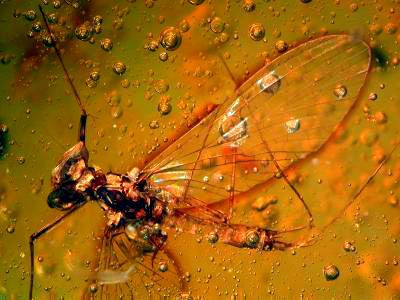16 Million Year Old Amber Fossil Reveals Unknown Insect "Hitchhiking" Behaviors

Spectacular images from a CT scan of a 16 million-year-old piece of amber have revealed the first evidence of an insect using another for transport.
Researchers at the University of Manchester say that the tiny preserved insect hitching a ride on top of another shows animal behaviors taking place today but which has never been previously recorded, according to the report published Oct. 17 in the open access journal PLOS ONE.
Forever encased in Dominican amber, a tiny springtail the size of a grain of salt can be seen sitting in a v-shaped depression at the base on one of the wings of an adult mayfly. As it rests it appears to have secured itself for transport using its prehensile antennae.
Researchers led by David Penney, from the Faculty of Life Sciences and the School of Materials, used a high resolution CT scanner to take over 3,000 X-rays from different angles. Penney and his team then created slices that showed the fossil in cross sections to create 3D digital images so that an accurate analysis of the springtail's behavior could be conducted.
"The images are really impressive. This pioneering approach to studying fossils has allowed us an insight into the behavior of one of the world's most prevalent organisms," Penney said in a statement.
Springtails are tiny creatures that are usually only 1-2mm long. These insects are found in large numbers in soil across the world and belong to the most abundant groups of animals in the world.
Gardeners will recognize them as the insect that hops around when soil is disturbed. These small creatures readily colonize newly-formed islands, but researchers do not know how they manage to migrate.
Researchers said that one of the reasons why so little is known about them is because springtails are incredibly nervous creatures and have are very effective at leaping away from danger using a springing organ (the furca) on the underside of the abdomen, making them hard to observe in life.
Researchers pointed out that the resulting 3D images of the springtail and mayfly entombed in amber shows that the springtail is very slightly detached from the mayfly, by about 50 micrometer, suggesting that it was attempting to spring away as the amber set around it.
Previous studies suggested that the springtails might have travelled across the world through the wind or ocean currents. Other studies found phoresy, transportation of one organism by another, in springtails also encased in amber. The previous case was found in a piece of Baltic amber where five springtails were hooked in a row on the leg of a harvestman arachnid.
The latest findings have led researchers to suggest that springtails may have hitchhiked on flights as another way to spread across the globe.
Researcher will now study whether present-day springtails catch rides on flying insects as well.



























